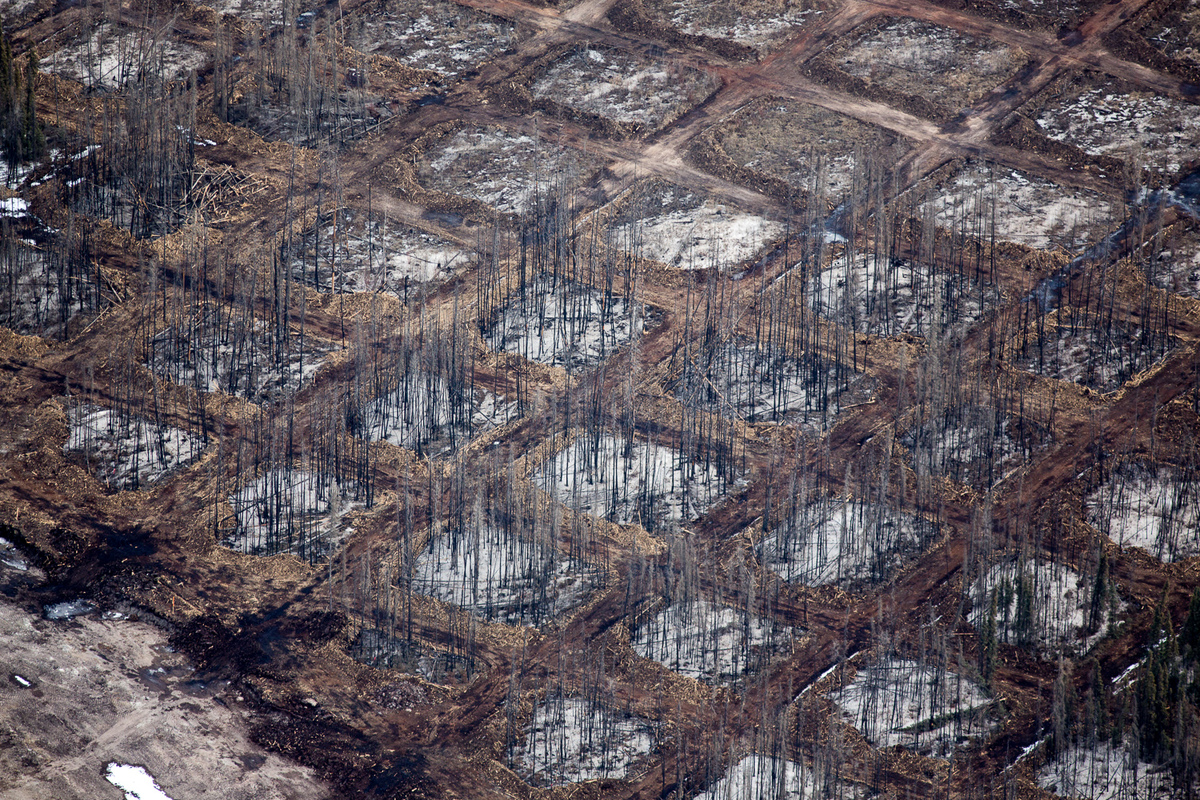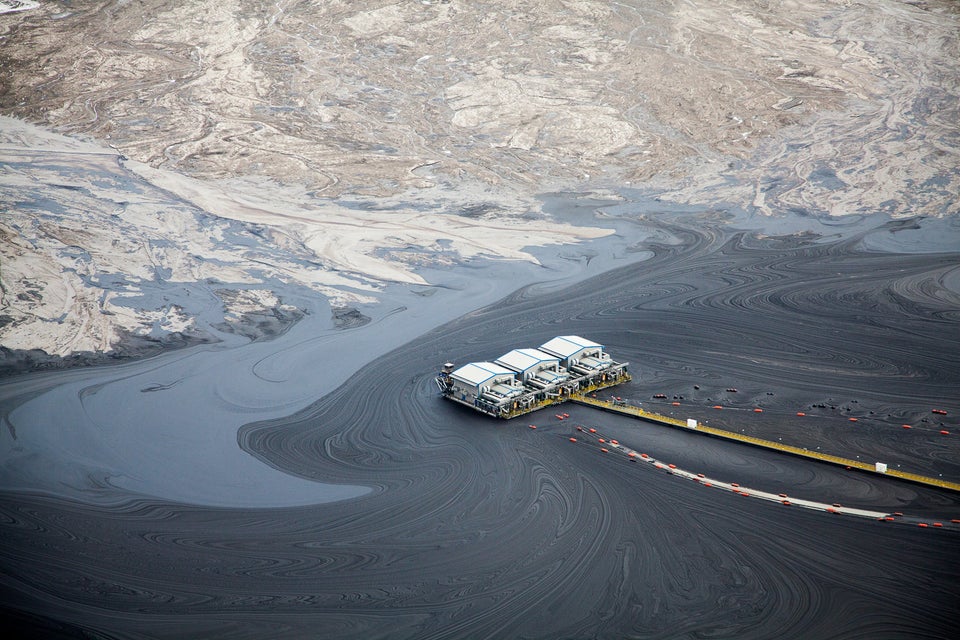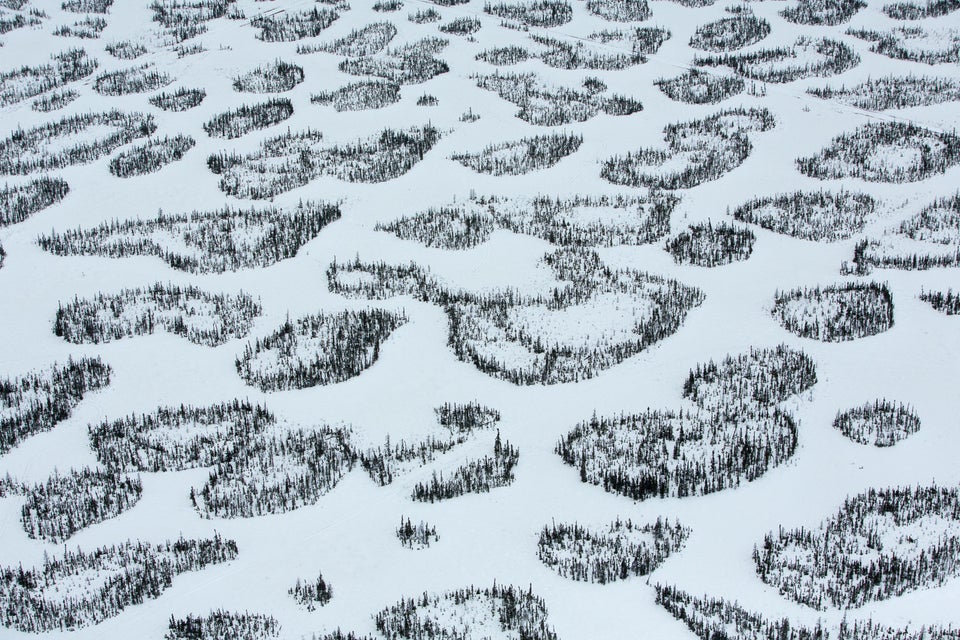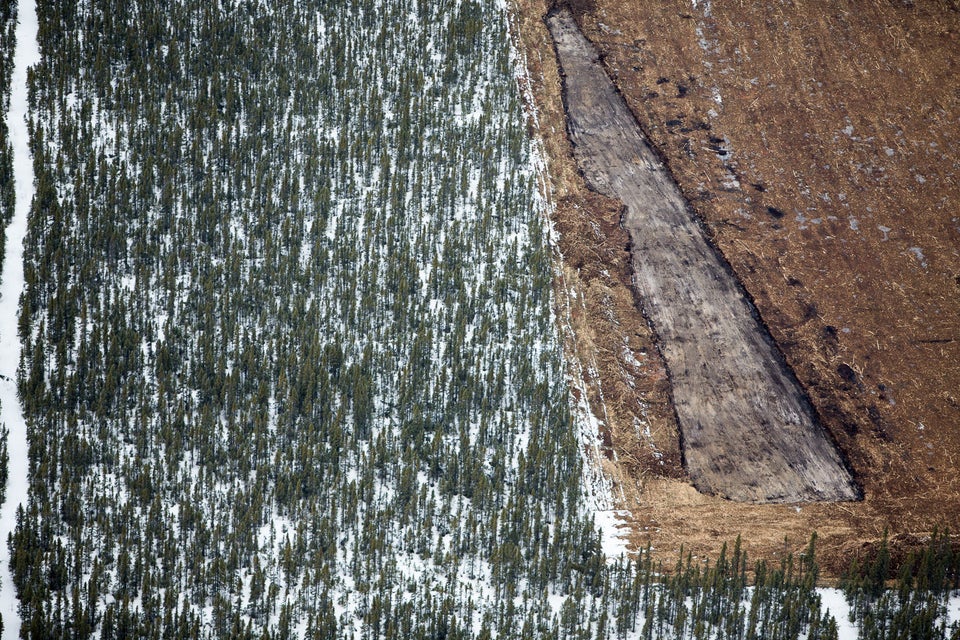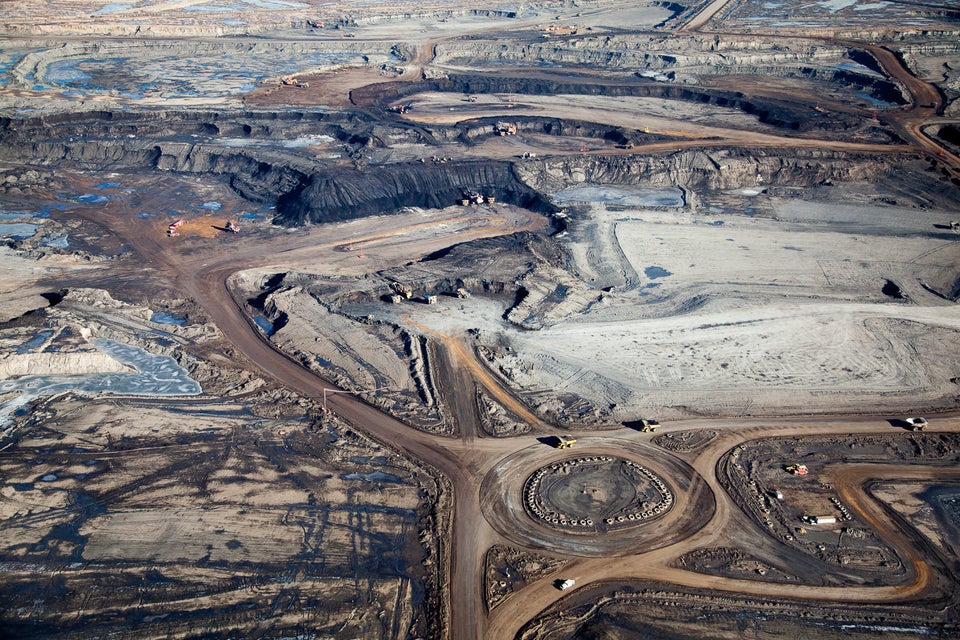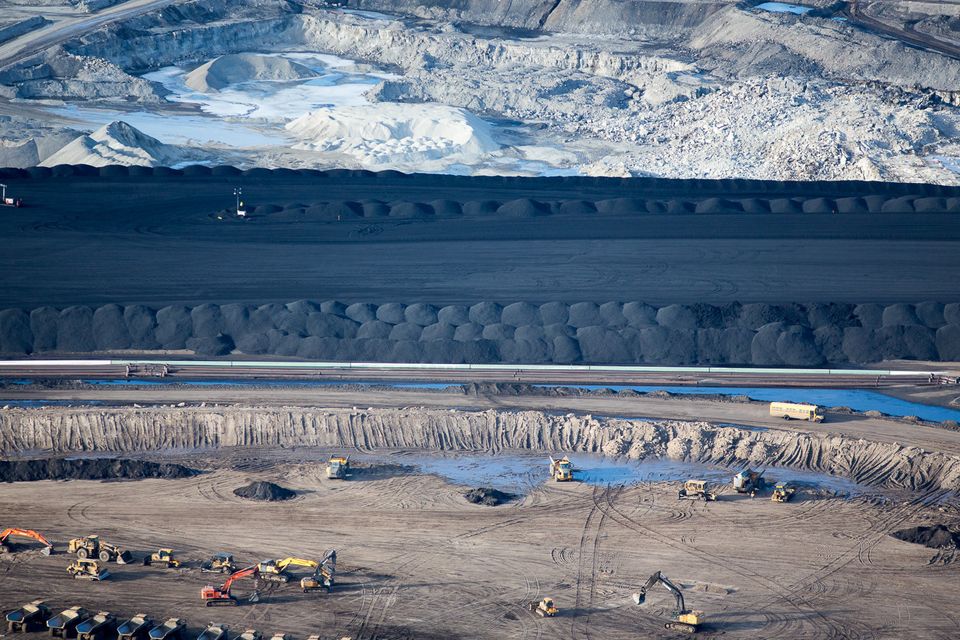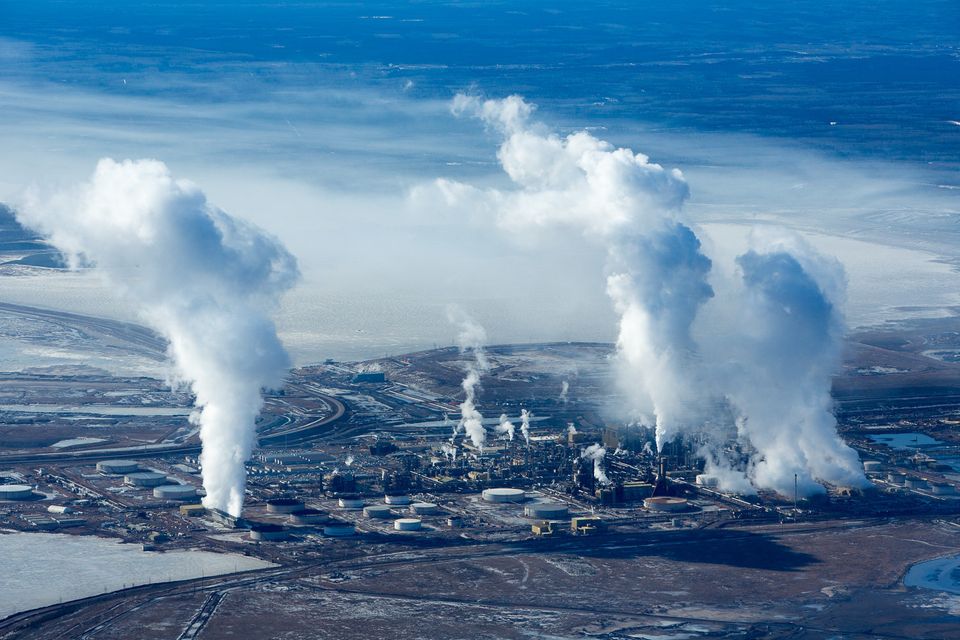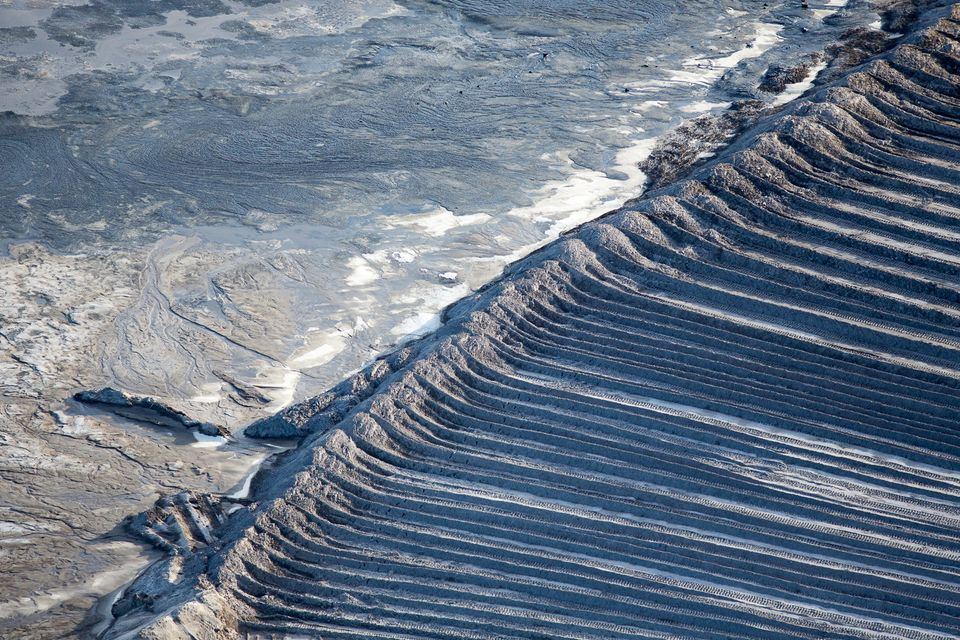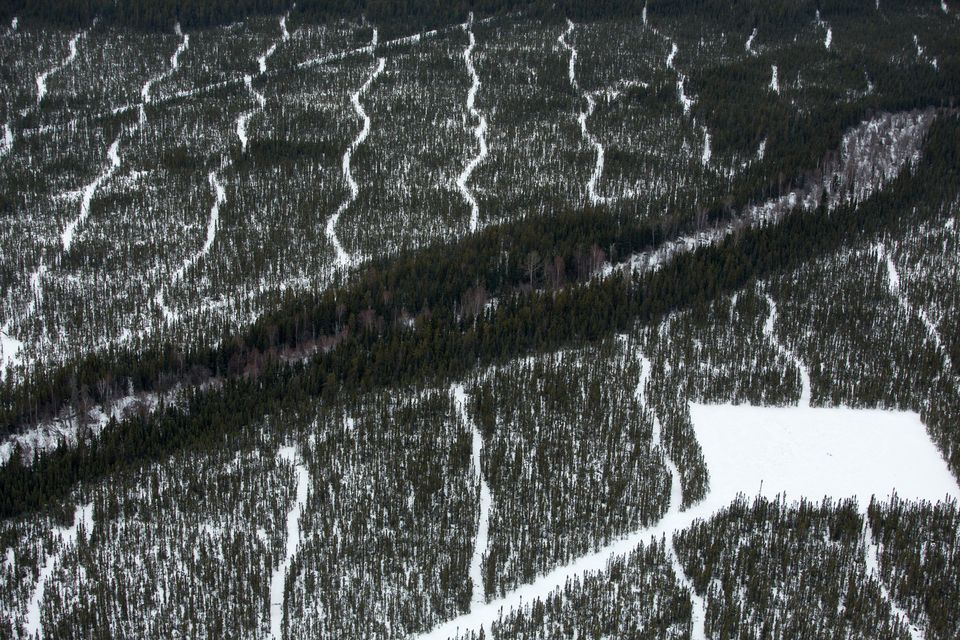Photographer and pilot Alex MacLean wanted to learn more about the Keystone XL pipeline, which if approved will carry oil from Canada to the Gulf of Mexico, so he decided to take pictures from above of the tar sands that will supply oil to the project.
What he found shocked him.
"The scale of the operation is staggering," MacLean told The Huffington Post. It's "mind-boggling," he said, how expansive it is, and how much money is being poured into drilling and strip mining for the viscous petroleum product that will give the Keystone XL pipeline its oil.
Hot waste fills a tailing pond at the Suncor mining site in Alberta.
MacLean took photos from 1,000 feet above northern Alberta's oil operations. The tar sands, more commonly referred to in Canada as the oil sands, are the world's third-largest petroleum reserve and underlie an area roughly the size of Florida. While the Alberta government says only 3 percent of the area is suitable for strip mining, in which forest and bog "overburden" is stripped away, that still amounts to about 1,850 square miles -- an area larger than the state of Rhode Island.
Flying above wilderness beauty punctuated by slick oil sheens and puffs of smoke from a refinery, "you realize how wasteful we are," MacLean said.
As of early 2013, mining operations had disturbed about 276 square miles of boreal forest in the region, according to the Pembina Institute, a nonprofit Canadian think tank focused on energy. The area totals over half the size of the city of Los Angeles.
The project "impressed on me, more than ever, just what the demand is for petroleum products downstream," MacLean said, and it shows how that demand drives "vast destruction of natural systems."
According to MacLean, some Albertans supported the idea of the project, but felt the growth has been too rapid and poorly managed. But among scientists and researchers, he said, there's a "real feeling that the environment is being poisoned, with both water and air pollution."
Checkerboard clearing of the overburden at the Syncrude Aurora North Mine Site in Alberta.
A University of Toronto study published earlier this year in the Proceedings of the National Academy of Sciences found that official environmental impact assessments have likely underestimated toxic emissions from tar sands operations. Another recent study found that the Alberta work is polluting groundwater and the nearby Athabasca River.
MacLean previously told Fast Company he hopes his work "will expose why this fuel is so carbon intensive and how the extraction process is polluting both the water and air."
The oil derived from the tar sands bitumen is 14 to 17 percent more carbon intensive over its lifecycle than traditional crude. If built, the Keystone XL pipeline would bring 830,000 barrels of this oil to market every day -- adding several million metric tons of carbon dioxide to the atmosphere annually.
"After seeing it in person, it seems like a really bad idea," MacLean told HuffPost of the pipeline. "It looks like really organized bad behavior on a large scale, for what the implications are."
See more of MacLean's photos below:
Steam and smoke rises at Syncrude's Mildred Lake upgrade refinery.
Skimming operations are seen at a tailings pond at a Suncor mining site in Alberta, Canada.
Surface oil on a tailings pond in Alberta, Canada in 2014.
The earthen wall of a tailing pond in Alberta, Canada in 2014.
Patches of boreal forest are intertwined with snow-covered muskeg, a type of soil, in Alberta, Canada.
Forest has been removed for an exploratory well pad at the Shell Jackpine mining site north of Fort McMurray, Alberta.
Seismic lines and a well pad at the Shell Jackpine mining site in Alberta.
Bitumen is excavated at the Syncrude Mildred Lake mining site. Giant tires line the traffic circle.
These are piles of uncovered petroleum coke, a byproduct of upgrading tar sands oil to synthetic crude.
Here the Athabasca River runs in to Lake Athabasca in northern Alberta, Canada in 2014.
MacLean's work was made possible with support from the Pulitzer Center on Crisis Reporting and The GroundTruth Project as part of a report to be published on GlobalPost next month.
Support HuffPost
Our 2024 Coverage Needs You
Your Loyalty Means The World To Us
At HuffPost, we believe that everyone needs high-quality journalism, but we understand that not everyone can afford to pay for expensive news subscriptions. That is why we are committed to providing deeply reported, carefully fact-checked news that is freely accessible to everyone.
Whether you come to HuffPost for updates on the 2024 presidential race, hard-hitting investigations into critical issues facing our country today, or trending stories that make you laugh, we appreciate you. The truth is, news costs money to produce, and we are proud that we have never put our stories behind an expensive paywall.
Would you join us to help keep our stories free for all? Your contribution of as little as $2 will go a long way.
Can't afford to donate? Support HuffPost by creating a free account and log in while you read.
As Americans head to the polls in 2024, the very future of our country is at stake. At HuffPost, we believe that a free press is critical to creating well-informed voters. That's why our journalism is free for everyone, even though other newsrooms retreat behind expensive paywalls.
Our journalists will continue to cover the twists and turns during this historic presidential election. With your help, we'll bring you hard-hitting investigations, well-researched analysis and timely takes you can't find elsewhere. Reporting in this current political climate is a responsibility we do not take lightly, and we thank you for your support.
Contribute as little as $2 to keep our news free for all.
Can't afford to donate? Support HuffPost by creating a free account and log in while you read.
Dear HuffPost Reader
Thank you for your past contribution to HuffPost. We are sincerely grateful for readers like you who help us ensure that we can keep our journalism free for everyone.
The stakes are high this year, and our 2024 coverage could use continued support. Would you consider becoming a regular HuffPost contributor?
Dear HuffPost Reader
Thank you for your past contribution to HuffPost. We are sincerely grateful for readers like you who help us ensure that we can keep our journalism free for everyone.
The stakes are high this year, and our 2024 coverage could use continued support. If circumstances have changed since you last contributed, we hope you’ll consider contributing to HuffPost once more.
Already contributed? Log in to hide these messages.

